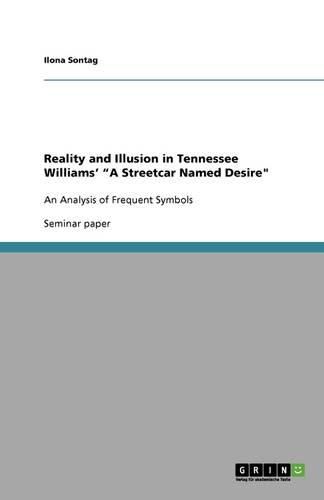Readings Newsletter
Become a Readings Member to make your shopping experience even easier.
Sign in or sign up for free!
You’re not far away from qualifying for FREE standard shipping within Australia
You’ve qualified for FREE standard shipping within Australia
The cart is loading…






This title is printed to order. This book may have been self-published. If so, we cannot guarantee the quality of the content. In the main most books will have gone through the editing process however some may not. We therefore suggest that you be aware of this before ordering this book. If in doubt check either the author or publisher’s details as we are unable to accept any returns unless they are faulty. Please contact us if you have any questions.
Seminar paper from the year 2009 in the subject English - Literature, Works, grade: 1,7, RWTH Aachen University (Institut fur Anglistik I), course: Hauptseminar American Drama , language: English, abstract: Tennessee Williams, born Thomas Lanier Williams, is not only known for being a talented, perceptive and influential American playwright (Day 1987, vii), but also for his frequent use of symbols. A Streetcar Named Desire (1947), the work which will be dealt with in this paper, is a good example for of usage, since it contains a lot of different kinds of symbolism, for example concerning colours, names, music and many more. Numerous works will be found, if anyone searches for essays about symbolism in Williams’ works. Moreover, it is common knowledge that Streetcar is a play which deals not only superficially with a woman going insane, but a play which bring[s] into violent contrast a neurotic woman’s dream world and the animalistic realism of her brother-in-law (back of the book in the Diesterweg edition). But since there does not seem to be any work which deals with the question of how exactly Williams drew this contrast by use of symbolism, it will be my aim in this paper to analyse this question. Consequently, I will try to point out the main symbols with which Williams underlined the contrast between realism and illusion, especially considering names, colours, clothes, light, music and certain rituals of the main characters. In the second part of this paper, I will deal with the question to what degree the main characters Stanley and Blanche are strictly opposed to each other or may have something in common. I will also deal with the meaning of the ending concerning realism and illusion. Therefore, what will be discussed are the most striking antinomies and similes in the main characters’ attitudes. A general conclusion about the topic of symbolism in Tennessee Williams’ Streetcar will be given in the end. To introduce the reader to the topic an
$9.00 standard shipping within Australia
FREE standard shipping within Australia for orders over $100.00
Express & International shipping calculated at checkout
Stock availability can be subject to change without notice. We recommend calling the shop or contacting our online team to check availability of low stock items. Please see our Shopping Online page for more details.
This title is printed to order. This book may have been self-published. If so, we cannot guarantee the quality of the content. In the main most books will have gone through the editing process however some may not. We therefore suggest that you be aware of this before ordering this book. If in doubt check either the author or publisher’s details as we are unable to accept any returns unless they are faulty. Please contact us if you have any questions.
Seminar paper from the year 2009 in the subject English - Literature, Works, grade: 1,7, RWTH Aachen University (Institut fur Anglistik I), course: Hauptseminar American Drama , language: English, abstract: Tennessee Williams, born Thomas Lanier Williams, is not only known for being a talented, perceptive and influential American playwright (Day 1987, vii), but also for his frequent use of symbols. A Streetcar Named Desire (1947), the work which will be dealt with in this paper, is a good example for of usage, since it contains a lot of different kinds of symbolism, for example concerning colours, names, music and many more. Numerous works will be found, if anyone searches for essays about symbolism in Williams’ works. Moreover, it is common knowledge that Streetcar is a play which deals not only superficially with a woman going insane, but a play which bring[s] into violent contrast a neurotic woman’s dream world and the animalistic realism of her brother-in-law (back of the book in the Diesterweg edition). But since there does not seem to be any work which deals with the question of how exactly Williams drew this contrast by use of symbolism, it will be my aim in this paper to analyse this question. Consequently, I will try to point out the main symbols with which Williams underlined the contrast between realism and illusion, especially considering names, colours, clothes, light, music and certain rituals of the main characters. In the second part of this paper, I will deal with the question to what degree the main characters Stanley and Blanche are strictly opposed to each other or may have something in common. I will also deal with the meaning of the ending concerning realism and illusion. Therefore, what will be discussed are the most striking antinomies and similes in the main characters’ attitudes. A general conclusion about the topic of symbolism in Tennessee Williams’ Streetcar will be given in the end. To introduce the reader to the topic an